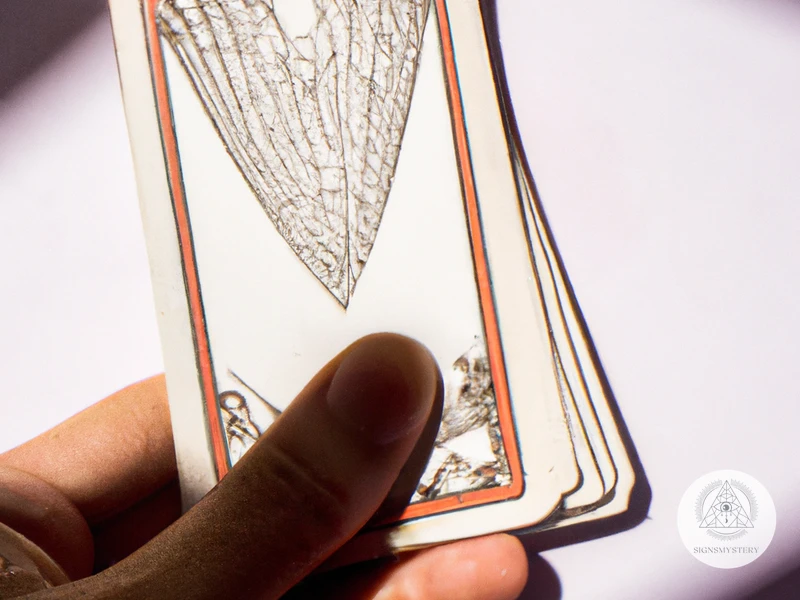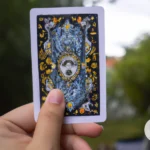As we journey through life, we come face to face with parts of ourselves that we may not be entirely comfortable with or aware of. These aspects of ourselves, known as our shadow, can hold a great deal of power over our actions and emotions if left unexplored. However, through the use of tarot cards and intentional reflection, we can begin to understand and transform our shadow selves. In particular, the minor arcana, with its rich symbolism and depiction of everyday situations, is a powerful tool for illuminating our inner world. In this guide, we will delve into the world of shadow work and explore how the minor arcana can be used to aid in our journey towards inner transformation.
Understanding Shadow Work

As we delve deeper into our psyche, we will undoubtedly come across aspects of ourselves that we may not have been aware of before. It can be easy to dismiss these parts of ourselves and push them away, but by doing so, we deny ourselves the opportunity for growth and self-awareness. This is where shadow work comes in. The process of shadow work can be daunting, but its rewards are immense as it allows us to confront and heal the traumas and subconscious beliefs that hold us back in life. In this section, we will explore what shadow work is, why it is important and how tarot cards can be a powerful tool in this process. Will discuss how the minor arcana can assist in uncovering subconscious patterns and beliefs that limit our growth. Let’s explore the power of the minor arcana in shadow work.
What is Shadow Work?
Shadow work is a process of self-discovery that involves examining and integrating the parts of ourselves that we typically keep hidden or repressed. It is a term coined by the Swiss psychologist Carl Jung, who believed that the unconscious mind holds valuable insights and wisdom that can help us grow and evolve as individuals. Shadow work involves identifying and confronting our inner shadows, which are aspects of our personality that we reject or suppress, such as our fears, insecurities, and negative beliefs. These shadows can lead to self-limiting patterns of behavior and can hold us back from achieving our full potential.
Tarot cards can be a powerful tool for inner shadow work. They offer a visual representation of our unconscious mind and can help us connect with the deeper parts of ourselves that we may not be aware of. By using tarot cards for shadow work, we can gain insight into our subconscious beliefs and patterns of behavior and begin to heal and integrate these hidden aspects of ourselves.
Through shadow work, we can confront and heal past traumas and negative experiences that may be holding us back from achieving our goals. It can help us uncover and challenge our subconscious beliefs, which often dictate our behavior without us realizing it. By bringing these hidden aspects of ourselves into the light, we can gain a greater sense of self-awareness and develop a deeper understanding of our motivations and desires.
Shadow work is a powerful practice that can lead to deep self-reflection and growth. By using tarot cards to explore our inner world, we can unlock a wealth of insight and wisdom that can help us overcome our limitations and achieve our full potential. In the next section, we will explore the power of the Minor Arcana and how it can be used for shadow work.
Why is Shadow Work Important?
Shadow work is a process of inner exploration and healing, where we confront and integrate the parts of ourselves that we have repressed or denied. It is the journey of confronting our deepest fears, negative beliefs, and past traumas. Although it may seem intimidating at first, shadow work is an essential step towards personal growth and transformation.
By facing and embracing our shadow self, we are able to experience true healing and growth. This leads to a greater sense of self-awareness, self-acceptance, and inner peace. Shadow work helps us overcome our limitations, break free from harmful patterns, and make progress on our spiritual journey.
Through the use of tarot cards, we can delve deeper into our unconscious mind and explore our innermost thoughts, feelings, and desires. Tarot cards act as a tool for self-reflection and growth, which can aid in the process of shadow work. By using tarot cards for shadow work, we can gain greater insight into our emotional patterns, core beliefs, and hidden desires.
To learn more about how tarot cards can be used for shadow work, check out our guide to Jungian-style shadow work with tarot. In the next section, we will explore the significance of the minor arcana in this process.
How Can Tarot Cards Help with Shadow Work?
Tarot cards have been used for centuries as a tool for divination and self-discovery. They can also be a powerful aid in shadow work. Essentially, tarot cards can help us by providing a mirror to our inner world, and by offering us symbols and stories to explore and work through.
One way tarot cards can help with shadow work is by illuminating our unconscious patterns and beliefs. Often, we are not aware of the ways in which we are sabotaging ourselves or repeating the same negative patterns over and over. By drawing certain cards, we can see parts of ourselves or our behaviors that we may have been blind to before, and begin to work through them.
Tarot cards can also act as a guide through our emotions and experiences. When doing shadow work, it can be challenging to stay present and open to our feelings, especially if they are painful or challenging. Tarot cards can provide a container for these emotions, allowing us to explore them in a safe and guided manner.
Finally, tarot cards can help us to access our inner wisdom and intuition. Often, when we are trying to work through our shadows, we are met with resistance or fear. By turning to tarot cards, we can tap into a deeper part of ourselves that knows what we need to heal and transform.
Tarot cards can be an incredibly useful tool for shadow work. They can help us to gain clarity and insight into our inner worlds, as well as provide guidance and support as we work through our shadows.
Click here for a guide on how to use tarot cards for a shadow work spread, or check out our article on using tarot for self-reflection and growth.
The Power of the Minor Arcana
As we dive deeper into the world of tarot and self-exploration, it’s important to understand the significance of the minor arcana. These 56 cards may seem less important than the major arcana, but they hold immense power in their symbolism and representation of everyday life experiences. Through the minor arcana, we can better understand our own inner world and find guidance in our journey of self-reflection and growth. Let’s explore the power of the minor arcana and how they can aid us in our shadow work.
What is the Minor Arcana?
The Minor Arcana is one of the two main divisions of a traditional Tarot deck. It consists of four suits, each containing cards numbered from Ace to 10, as well as four Court cards: Page, Knight, Queen, and King. The four suits are typically called Wands (or Rods), Cups, Swords, and Pentacles (or Coins).
Each suit in the Minor Arcana represents a different aspect of life and experience. Wands represent creativity, passion, and action. Cups represent emotions, relationships, and intuition. Swords represent the mind, communication, and challenges. Pentacles represent the physical world, material possessions, and abundance.
The Minor Arcana is often associated with everyday experiences and events, as well as with our inner world and personal growth. While the Major Arcana represents powerful archetypes and universal themes, the Minor Arcana can offer more specific insights and guidance.
In the context of shadow work, the Minor Arcana can help us explore the different aspects of ourselves that we may have repressed or denied. Each suit and card can symbolize a different pattern, belief, or behavior that we have internalized and may need to examine more closely. By working with the Minor Arcana cards, we can gain a deeper understanding of our inner world and move towards greater self-awareness and healing.
If you’re interested in learning more about using Tarot cards for self-reflection and growth, check out our article on Tarot for Self-Reflection and Growth.
How Does the Minor Arcana Represent Our Inner World?
The Minor Arcana in tarot cards consists of four suits, each representing a different aspect of our inner world. These suits are Wands, Cups, Swords, and Pentacles. Each suit consists of 14 cards, with 10 numbered cards and 4 court cards – Page, Knight, Queen, and King.
– Wands: Represent the element of fire, creativity, passion, and action. The Wands are associated with our inner drive to pursue our passions and take bold actions towards our goals. In terms of shadow work, the Wands may represent the parts of ourselves that we are afraid to express or the beliefs that hold us back from taking action towards our true desires.
– Cups: Represent the element of water, emotions, relationships, and intuition. The Cups are associated with our ability to connect with our feelings and the feelings of others. In terms of shadow work, the Cups can represent the emotions and relationships that we struggle with, the parts of ourselves that we may hide from others or even ourselves.
– Swords: Represent the element of air, thoughts, communication, and conflict. The Swords are associated with our intellect and ability to communicate our thoughts and ideas. In terms of shadow work, the Swords can represent the inner conflicts and negative self-talk that we may struggle with.
– Pentacles: Represent the element of earth, material possessions, health, and stability. The Pentacles are associated with our physical world and our ability to manifest abundance and stability. In terms of shadow work, the Pentacles can represent the limiting beliefs and scarcity mindset that keep us from experiencing abundance and prosperity.
Understanding the meaning behind each suit and its associated element can help us better connect with our inner world and identify areas of growth and healing. By exploring each suit through the lens of shadow work, we can use the Minor Arcana as a tool for inner transformation and self-discovery.
Exploring Each Suit of the Minor Arcana and Their Relevance to Shadow Work
When working with tarot cards, it is important to have a strong understanding of the Minor Arcana and their relevance to shadow work. The Minor Arcana is divided into four suits: Wands, Cups, Swords, and Pentacles. Each suit represents different aspects of our inner world and can offer important insights into our shadows.
The Wands: The suit of Wands is associated with action, creativity, and passion. When exploring our shadows, the Wands can symbolize any repressed or suppressed desires and creative urges. This suit can offer us guidance on how to harness our inner fire and take action towards manifesting our desires.
The Cups: The suit of Cups is associated with emotions, intuition, and relationships. When exploring our shadows, the Cups can represent unresolved emotional wounds, issues related to self-love, and repressed feelings. This suit can offer us guidance on how to cultivate compassion, self-love, and healthy relationships.
The Swords: The suit of Swords is associated with thought, communication, and truth. When exploring our shadows, the Swords can represent negative self-talk, harsh judgments, and limiting beliefs. This suit can offer us guidance on how to reframe our thoughts and communicate truth in a healthy and productive way.
The Pentacles: The suit of Pentacles is associated with the physical world, abundance, and manifestation. When exploring our shadows, the Pentacles can represent issues related to money, self-worth, and material possessions. This suit can offer us guidance on how to cultivate a healthy relationship with money and abundance, and to manifest our desires in a way that aligns with our values.
By understanding the relevance of each suit to shadow work, we can gain deeper insights into our inner world and take steps towards healing and transformation.
How to Use the Minor Arcana for Shadow Work

Now that we understand the role that the Minor Arcana plays in shadow work, it’s time to dive into how we can use these cards for inner transformation. Using tarot cards for shadow work can be a powerful tool for gaining insight into our unconscious patterns and beliefs. This section will guide you through the process of setting your intention, shuffling and drawing the cards, interpreting them, and reflecting on their messages. By using the Minor Arcana in this way, we can access the rich symbolism and archetypes present in each card to gain a deeper understanding of ourselves and our shadow aspects. So, let’s explore how we can use the Minor Arcana for transformative shadow work.
Setting Your Intention and Creating a Sacred Space
Setting Your Intention and Creating a Sacred Space:
Before beginning any shadow work practice with tarot cards, it is important to set your intention and create a sacred space. This can help you to focus your energy and cultivate a safe and supportive environment for inner exploration. Here are some steps to consider:
- Find a quiet and private space where you will not be disturbed. This could be a room, a corner of your home, or even outdoors in nature.
- Cleanse the space with sage or other purifying herbs, or light candles or incense to create a peaceful and grounding atmosphere.
- Set your intention for the practice. This could be a general intention for inner exploration and growth, or a more specific intention related to a particular issue or challenge you are facing.
- Write down your intention in a journal, or simply hold it in your mind as you begin the practice.
- Visualize a protective bubble or shield around yourself, as a way to create a sense of safety and boundaries within the sacred space.
- Take a few deep breaths and release any tensions or worries that may be lingering in your mind or body. Allow yourself to be fully present in the moment and open to the guidance of the cards.
Remember that creating a sacred space is a personal and individual practice, and you can always modify or adapt these steps to suit your own needs and preferences. The important thing is to be intentional and mindful as you begin your shadow work journey with tarot cards.
Shuffling and Drawing the Cards
Shuffling and Drawing the Cards:
Once you have set your intention and created a sacred space, you can begin to shuffle and draw the tarot cards. Here are some steps you can follow:
- Start by shuffling the cards thoroughly. Take as much time as you need to shuffle until you feel ready to draw a card.
- When you are ready, cut the deck into three piles and choose the one that feels most aligned with your intention for the reading.
- Draw one card from the top of the chosen pile and place it face up in front of you.
- Take a few moments to look at the card and notice any initial impressions or emotions that come up for you.
- Reflect on the card’s imagery, symbolism, and meaning. How does this card relate to your current situation or inner world?
- You can also explore the card’s upright and reversed meanings to gain further insight.
- Pay attention to any personal associations or connections you may have with the card.
- Journal your thoughts and feelings about the card, and any insights or realizations that come up for you.
- You can repeat this process with additional cards as desired, or simply focus on the one card you drew.
- Remember to trust your intuition and allow yourself to be open to any messages or guidance that come through the cards.
Remember, the purpose of shadow work with tarot is to gain insight and understanding into your unconscious patterns and tendencies. Don’t be afraid to confront difficult emotions or truths that may arise during the process. Trust that the cards, as powerful guides, will help you navigate through the shadows towards the light of inner transformation.
Interpreting the Cards and Connecting Them to Your Inner World
Once you have drawn your cards and laid them out in front of you, it is time to start interpreting their meanings and connecting them to your inner world. This process can be done in a few simple steps using the following process:
| Step 1: | Observe the cards and their symbols |
| Step 2: | Consider the traditional meanings of the cards and their positions in the spread |
| Step 3: | Reflect on how the cards relate to your current situation and emotions |
| Step 4: | Notice any patterns or recurring themes among the cards |
| Step 5: | Use your intuition to make connections and draw insights from the cards |
It’s important to approach this process with an open mind and without judgment. Remember that the goal of shadow work is to confront and accept the parts of ourselves we may not like or want to acknowledge. The tarot cards can help uncover these hidden aspects of ourselves so that we can work towards healing and transformation.
As you interpret each card, consider how it relates to your personal experiences and emotions. For example, if you draw the Three of Swords, which traditionally represents heartbreak and emotional pain, reflect on any recent experiences of betrayal or disappointment that may be weighing on you. Think about what lessons you can learn from this experience and how you can move forward in a more positive way.
It can be helpful to write down your interpretations and reflections during this process. This allows you to track your progress over time and see how your understanding of the cards and their meanings evolve as you continue to do shadow work.
Remember that this process is not about getting the “right” interpretation. It’s about using the tarot cards as a tool for self-reflection and discovery. Trust your own intuition and insights as you make connections between the cards and your inner world.
Journaling and Reflection
After interpreting the cards you drew, it’s time to engage in some journaling and reflection. This is a crucial part of the process, as it allows you to take the insights you gained from the cards and apply them to your life in a deeper way.
To get started, take out your tarot journal or a blank notebook and write down the cards you drew. Then, go through each card one by one and jot down any thoughts or feelings that arose during your interpretation. You can also use the symbolism and imagery of the cards as prompts to delve deeper into your emotions and experiences.
Once you have written down your initial impressions, take some time to reflect on them. Ask yourself questions like:
- What emotions did this card evoke?
- How does this card relate to my current situation or challenge?
- What can I learn from this card?
Allow yourself to sit with these questions and really explore your responses in depth. This process of self-inquiry can unlock hidden parts of yourself and help you better understand your motivations, fears, and desires.
As you reflect, remember to be gentle with yourself. Shadow work can be intense and emotionally challenging, so it’s important to practice self-care throughout the process. Take breaks when you need to, engage in activities that bring you joy, and seek support from loved ones or
Subscribe to Our Newsletter
Sign up to receive the latest news and updates.
Overall, journaling and reflection are invaluable tools for integrating the insights gained from tarot cards into your daily life. By exploring your inner world in this way, you can foster greater self-awareness, heal past wounds, and cultivate a deeper sense of inner peace and fulfillment.
| Tips for Effective Journaling and Reflection |
|---|
| 1. Schedule regular journaling sessions to stay consistent with your practice. |
| 2. Use prompts or questions to guide your journaling if you feel stuck. |
| 3. Allow yourself to write freely without worrying about grammar or structure. |
| 4. Revisit your journal entries over time to track your progress and growth. |
Examples and Exercises
Looking for inspiration and practical applications of shadow work with the Minor Arcana? In this section, we’ll dive into some examples of spreads and exercises that you can use to deepen your understanding of yourself, your shadows, and how to work with them through tarot. These examples and exercises are designed to help you get started with your own exploration and provide a framework for incorporating the Minor Arcana into your own inner transformation. So grab your deck, find a quiet space, and let’s dive in together.
Example Spreads for Shadow Work
Shadow work can seem overwhelming, but using tarot cards can be a helpful tool in addressing our inner shadows. Here are some example spreads to guide you in your practice of using the Minor Arcana for shadow work.
| Spread Title | Number of Cards | Intentions |
|---|---|---|
| The Shadow Spread | 10 | To identify and reflect on your hidden aspects |
| The Healing Spread | 5 | To explore the steps towards healing and transformation |
| The Release and Let Go Spread | 6 | To identify and release the emotions and beliefs that hold you back |
| The Inner Conflict Spread | 4 | To explore the underlying issues of inner conflicts and resolve them |
It’s important to keep in mind that these are just examples, and you can tailor your spreads to your specific needs and intentions. Remember to set your intentions before the reading, and take time to reflect on the messages and insights that the cards reveal.
Exercise: Exploring Your Shadow through the Minor Arcana
One powerful way to start exploring your shadow through the Minor Arcana is to use an exercise that involves drawing a card from each suit and reflecting on its meaning in relation to your inner world. Here’s how to do it:
- First, shuffle the deck and ask for guidance on what aspects of your shadow self you need to focus on.
- Then, draw one card from each suit, paying attention to the message it holds.
- For the suit of Wands: Consider how this card relates to your passions, creativity, and desires. Does it represent something you’ve been suppressing or neglecting? Alternatively, does it bring up any feelings of anger or frustration?
- For the suit of Cups: This suit represents emotions, relationships, and intuition. What feelings does this card evoke in you, and how do these relate to your relationships with others and yourself?
- For the suit of Swords: This suit is associated with thoughts, beliefs, and communication. What mental patterns or beliefs are holding you back, and how can you work through them?
- For the suit of Pentacles: This suit represents material possessions, finances, and stability. How do your material needs and desires affect your inner world, and what kind of relationship do you have with abundance and wealth?
- Once you have reflected on each card individually, consider how they might relate to each other. Do you see any patterns or themes emerging? What insights do these cards offer about your shadow self, and how can you use them to promote growth and transformation?
- Write down your thoughts and feelings in a journal or notebook, and revisit them over time to track your progress and see how your relationship with your shadow evolves.
Remember that shadow work can be intense and challenging, but it can also be incredibly rewarding and transformative. Be gentle with yourself, and trust that the cards will offer you the guidance you need to uncover deeper truths about yourself and your inner world.
Tips for Effective Shadow Work and Inner Transformation
As you embark on your journey of shadow work and inner transformation, it’s important to remember that it’s not always an easy process. It can bring up difficult emotions and memories, and it’s essential to approach it with care and compassion. To help you on this path, we’ve compiled a list of tips and strategies that can aid in your journey towards greater self-awareness and healing. These suggestions include practicing self-care, seeking guidance from trusted sources, and incorporating various tools and practices into your routine. By utilizing these techniques, you can deepen your understanding of yourself and achieve a state of greater psychological well-being.
Practice Self-Care and Be Gentle with Yourself
It’s important to keep in mind that shadow work can be emotionally and mentally challenging. To ensure that you are taking care of yourself during this process, practicing self-care is crucial. Here are some tips:
- Give yourself permission to feel – It’s important to allow yourself to feel any emotions that come up during the process. Don’t try to suppress or ignore them. Accepting and acknowledging them is an important step in healing.
- Take breaks when needed – If you find yourself feeling overwhelmed or drained, it’s okay to take a break from the process. Listen to your body and take the time you need to re-energize.
- Self-compassion is key – Be kind and gentle with yourself. Remember that everyone has aspects of themselves that they struggle with. Practice self-compassion and avoid negative self-talk.
- Engage in activities that bring you joy – Shadow work can be heavy and intense, so make sure to balance it out with activities that bring you happiness and fulfillment. This can be as simple as taking a walk in nature or spending time with loved ones.
- Seek support if needed – If you find that you are struggling to cope with the process, don’t hesitate to seek support. This can be in the form of a therapist, a trusted tarot reader or a support group.
Remember that shadow work is a journey and it’s important to prioritize your well-being throughout the process.
Work with a Trusted Tarot Reader or Therapist
One of the most important things to understand about shadow work is that it can be a very intense and emotional process, which is why it’s crucial to have support from a trusted tarot reader or therapist. Working with a professional can help you navigate through difficult emotions and provide you with guidance and insight throughout your journey.
Benefits of working with a trusted tarot reader or therapist:
| 1. Receive support and guidance | Working with a professional allows you to receive support and guidance from someone who has experience in this field. They can help you navigate any challenges that may arise and provide you with the necessary tools and resources to continue your journey towards inner transformation. |
| 2. Gain clarity and insight | A trusted tarot reader or therapist can help you gain clarity and insight into your shadow self. They can provide you with a different perspective on your situation, which can be extremely helpful in understanding your emotions and behaviors. |
| 3. Create a safe and supportive environment | Working with a professional can create a safe and supportive environment for your shadow work. It allows you to feel comfortable and vulnerable as you explore your inner self, knowing that you have someone to lean on throughout the process. |
| 4. Have access to resources and tools | A trusted tarot reader or therapist can provide you with a variety of resources and tools to use during your shadow work. They may suggest different spreads, exercises, or meditation techniques to help you explore your inner self on a deeper level. |
| 5. Continue your journey towards inner transformation | Working with a professional is an investment in yourself and your journey towards inner transformation. They can help you stay on track, provide you with the necessary support and guidance, and push you further towards achieving your goals. |
It’s important to note that not all tarot readers or therapists are qualified to guide you through shadow work. It’s essential to find someone who has experience in this field and who you feel comfortable opening up to. Take your time and do your research to find the right person for you.
Remember, shadow work can be a challenging journey, but with the right support and guidance, it can also be incredibly transformative and empowering.
Use Tarot Cards in Combination with Other Tools and Practices
When it comes to shadow work and inner transformation, using tarot cards can be a powerful tool. However, it’s important to remember that tarot cards are just one of many tools and practices that can be used to facilitate this kind of growth. In fact, using tarot cards in combination with other tools and practices can often lead to even deeper and more meaningful insights.
Here are some other tools and practices that can be used in conjunction with tarot cards:
- Meditation: Meditation can be a helpful practice to do before or after a tarot reading. It can help you clear your mind, connect with your intuition, and prepare yourself for any insights that may come through during the reading.
- Journaling: Journaling is a great way to reflect on the insights you receive during a tarot reading. It can help you process your thoughts and emotions, identify patterns, and track your progress over time.
- Therapy: Working with a therapist or counselor can be a valuable addition to your shadow work journey. A trained professional can help you navigate any difficult emotions that come up during your tarot readings, as well as provide additional tools and support.
- Energy Work: Practices like reiki, acupuncture, or massage can help you release any energetic blockages that may be keeping you stuck in old patterns. They can also help you feel more relaxed and centered, making it easier to receive insights from your tarot readings.
- Self-Care: Taking care of yourself is a crucial part of any transformative journey. This can look different for everyone, but some common self-care practices include getting enough sleep, eating nutritious food, getting regular exercise, and spending time in nature.
Incorporating these tools and practices into your shadow work journey can help you:
- Become more grounded and centered
- Release old patterns and limiting beliefs
- Develop greater self-awareness and self-compassion
- Cultivate a deeper connection with your intuition
- Feel more empowered and confident
Remember, there is no one “right” way to approach shadow work and inner transformation. Each person’s journey is unique and requires a personalized approach. By using tarot cards in combination with other tools and practices, you can create a holistic and effective approach to your own shadow work journey.
Conclusion
In conclusion, using tarot cards for shadow work can be a powerful tool for inner transformation. By delving into the symbolism of the minor arcana, we are able to understand and explore our unconscious patterns and behaviors. The minor arcana reveals our desires, fears, and internal struggles, offering insights into our deepest selves.
However, it’s important to remember that shadow work can be a challenging and emotional process. It’s crucial to approach it with a sense of self-care and compassion for oneself. Utilizing tools like journaling, meditation, or working with a trusted tarot reader or therapist can provide support and guidance along the way.
Remember that the minor arcana is not a magic tool that can solve all our problems or provide easy answers. Rather, it’s a tool for self-reflection and discovery, and the insights gleaned from shadow work require time and effort to fully integrate into our lives.
If you are new to tarot cards or shadow work, take the time to explore each suit of the minor arcana and develop a deeper understanding of their symbolism. With practice and patience, you can harness the power of tarot cards and the minor arcana to gain greater insight into your inner world and drive transformation in your life.
Frequently Asked Questions
What is the difference between the Major and Minor Arcana?
The Major Arcana consists of 22 cards and represents major life events and archetypal energies, while the Minor Arcana consists of 56 cards and represents more everyday situations and experiences.
How can tarot cards help with personal growth?
Tarot cards can provide insight and guidance on personal issues, as well as help individuals become more self-aware and in tune with their inner world.
What does shadow work entail?
Shadow work involves facing and integrating aspects of ourselves that we may not be aware of or that we may try to hide from others and ourselves.
What if I don’t know how to interpret tarot cards?
It’s important to remember that tarot is a personal and intuitive practice, so there’s no right or wrong interpretation. You can use guidebooks, online resources, or work with a tarot reader to help enhance your understanding.
Can tarot cards predict the future?
Tarot cards can offer insights and guidance on possible outcomes, but they cannot predict the future with 100% certainty. Ultimately, we have the power to shape our own destiny.
What if I draw a “negative” card during my tarot reading?
All tarot cards have both positive and negative aspects, and drawing a “negative” card doesn’t necessarily mean something bad will happen. Use it as an opportunity to reflect on areas of growth and change.
Do I need to have a specific question in mind before doing a tarot reading?
Not necessarily. You can draw cards for general guidance or simply to explore your inner world. However, having a specific intention or question can help provide more focused and specific insights.
What if I don’t resonate with the traditional meaning of a tarot card?
Trust your intuition and personal connection to the card, as it may hold a unique meaning for you that isn’t necessarily reflected in traditional interpretations.
Do I need to believe in tarot for it to be effective?
No. While having an open mind and being willing to explore your inner world is helpful, you don’t need to believe in tarot for it to offer insight and guidance.
Can tarot cards be harmful or dangerous?
As long as you approach tarot with an open and respectful mindset, it should not be harmful or dangerous. However, if you feel uncomfortable or overwhelmed during a reading, it’s important to take a break and reassess.










